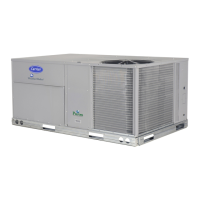15
Fig. 10 — Service Clearance Dimensions (applies to all 08-16 units, size 14 unit shown)
INSTALLATION
Jobsite Survey
Complete the following checks before installation.
1. Consult local building codes and the NEC (National Elec-
trical Code) ANSI/NFPA 70 for special installation
requirements.
2. Determine unit location (from project plans) or select unit
location.
3. Check for possible overhead obstructions which may
interfere with unit lifting or rigging.
Step 1 — Plan for Unit Location
Select a location for the unit and its support system (curb or
other) that provides for the minimum clearances required for
safety. This includes the clearance to combustible surfaces,
unit performance and service access below, around and above
unit as specified in unit drawings. See Fig. 10.
NOTE: Consider also the effect of adjacent units.
Unit may be installed directly on wood flooring or on Class A,
B, or C roof-covering material when roof curb is used.
Do not install unit in an indoor location. Do not locate air inlets
near exhaust vents or other sources of contaminated air.
Although unit is weatherproof, avoid locations that permit wa-
ter from higher level runoff and overhangs to fall onto the unit.
Select a unit mounting system that provides adequate height to al-
low for removal and disposal of frost and ice that will form during
the heating-defrost mode as well as allow installation of conden-
sate trap per requirements. Refer to Step 9 “Install External Con-
densate Trap and Line” on page 25 for required trap dimensions.
ROOF MOUNT
Check building codes for weight distribution requirements.
Unit operating weight is shown in Table 2.
Step 2 — Plan for Sequence of Unit Installation
The support method used for this unit will dictate different se-
quences for the steps of unit installation. For example, on curb-
mounted units, some accessories must be installed on the unit
before the unit is placed on the curb. Review the following for
recommended sequences for installation steps.
CURB-MOUNTED INSTALLATION
1. Install curb
2. Install field-fabricated ductwork inside curb
3. Install accessory thru-base service connection package
(affects curb and unit) (refer to accessory installation
instructions for details)
4. Prepare bottom condensate drain connection to suit planned
condensate line routing (refer to “Step 9 — Install External
Condensate Trap and Line” on page 25 for details)
5. Rig and place unit
6. Install outdoor air hood
7. Install condensate line trap and piping
8. Make electrical connections
9. Install other accessories.
NOTE: Unit not designed to have overhead obstruction. Contact Application Engineering for guidance on any application planning overhead
obstruction or for vertical clearances.
LOCATION DIMENSION CONDITION
A
48-in. (1219 mm)
18-in. (457 mm)
18-in. (457 mm)
12-in. (305 mm)
Unit disconnect is mounted on panel
No disconnect, convenience outlet option
Recommended service clearance
Minimum clearance
B
42-in. (1067 mm)
36-in. (914 mm)
Special
Surface behind servicer is grounded (e.g., metal, masonry wall)
Surface behind servicer is electrically non-conductive (e.g., wood, fiberglass)
Check sources of flue products within 10 ft (3 m) of unit fresh air intake hood
C
36-in. (914 mm)
18-in. (457 mm)
Side condensate drain is used
Minimum clearance
D
48 in. (1219 mm)
42-in. (1067 mm)
36-in. (914 mm)
Special
No flue discharge accessory installed, surface is combustible material
Surface behind servicer is grounded (e.g., metal, masonry wall, another unit)
Surface behind servicer is electrically non-conductive (e.g., wood, fiberglass)
Check for adjustable units or building fresh air intakes within 10 ft (3 m) of this units flue outlet

